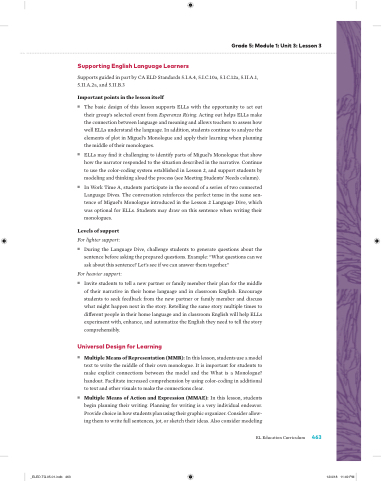Page 487 - EL Grade 5 Teacher Guide
P. 487
Grade 5: Module 1: Unit 3: Lesson 3
Supporting English Language Learners
Supports guided in part by CA ELD Standards 5.I.A.4, 5.I.C.10a, 5.I.C.12a, 5.II.A.1, 5.II.A.2a, and 5.II.B.3
Important points in the lesson itself
■ The basic design of this lesson supports ELLs with the opportunity to act out their group’s selected event from Esperanza Rising. Acting out helps ELLs make the connection between language and meaning and allows teachers to assess how well ELLs understand the language. In addition, students continue to analyze the elements of plot in Miguel’s Monologue and apply their learning when planning the middle of their monologues.
■ ELLs may nd it challenging to identify parts of Miguel’s Monologue that show how the narrator responded to the situation described in the narrative. Continue to use the color-coding system established in Lesson 2, and support students by modeling and thinking aloud the process (see Meeting Students’ Needs column).
■ In Work Time A, students participate in the second of a series of two connected Language Dives. The conversation reinforces the perfect tense in the same sen- tence of Miguel’s Monologue introduced in the Lesson 2 Language Dive, which was optional for ELLs. Students may draw on this sentence when writing their monologues.
Levels of support
For lighter support:
■ During the Language Dive, challenge students to generate questions about the sentence before asking the prepared questions. Example: “What questions can we ask about this sentence? Let’s see if we can answer them together.”
For heavier support:
■ Invite students to tell a new partner or family member their plan for the middle of their narrative in their home language and in classroom English. Encourage students to seek feedback from the new partner or family member and discuss what might happen next in the story. Retelling the same story multiple times to di erent people in their home language and in classroom English will help ELLs experiment with, enhance, and automatize the English they need to tell the story comprehensibly.
Universal Design for Learning
■
■
Multiple Means of Representation (MMR): In this lesson, students use a model text to write the middle of their own monologue. It is important for students to make explicit connections between the model and the What is a Monologue? handout. Facilitate increased comprehension by using color-coding in additional to text and other visuals to make the connections clear.
Multiple Means of Action and Expression (MMAE): In this lesson, students begin planning their writing. Planning for writing is a very individual endeavor. Provide choice in how students plan using their graphic organizer. Consider allow- ing them to write full sentences, jot, or sketch their ideas. Also consider modeling
EL Education Curriculum 463
_ELED.TG.05.01.indb 463
12/4/18 11:49 PM


